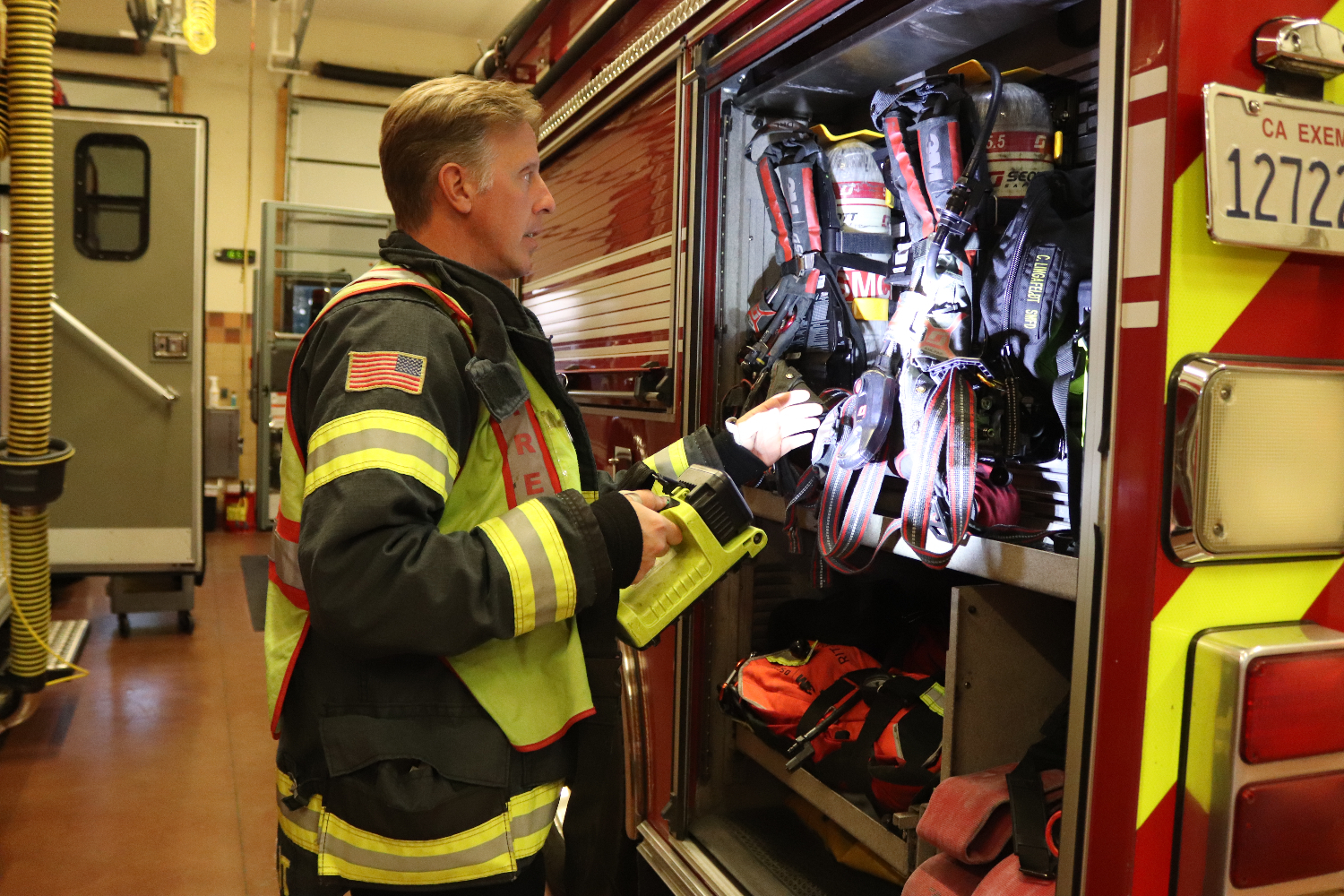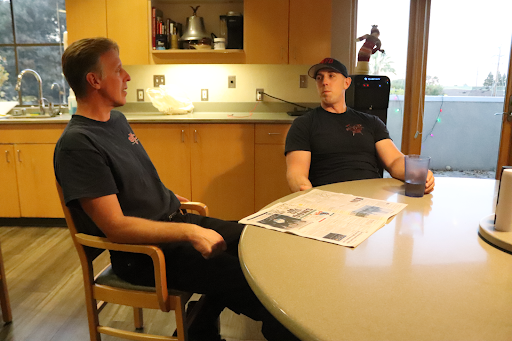Firefighters’ lives: building mental and physical resilience

According to the National Fallen Firefighters Foundation, approximately 20% of firefighters and paramedics meet the criteria for post-traumatic stress at some point in their careers, compared to a 6.8% lifetime risk for the general population.
The unpredictable nature of their work puts them in situations that can be traumatic and leave lasting emotional effects. While training and physical preparedness are essential, treating the mental toll of witnessing suffering and making life-altering decisions can be just as important.
“We’re here to help people through tough times, which can be traumatic. It’s mentally challenging because you see people at their lowest and want to do whatever you can to make them feel better,” said Jake Mattman, a firefighter at Station 15.
As the culture surrounding mental health in firefighting evolves, more departments recognize the importance of supporting their teams and helping firefighters cope with the psychological challenges they face.
To prepare for the mental aspect of their job, firefighters must go through longer shifts than most. The firefighters in Belmont, specifically, work 48-hour shifts.
Firefighters are organized into three rotating groups, A, B, and C, alternating through two-day shifts during the month. Each group works and sleeps at the station during their shift, then hands over responsibilities to the next group after their two days.
Arriving at 7 a.m., they must go through several different procedures. Although it differs depending on their role, the typical routine is to replace the gear on the engine of the firetruck, check the truck’s engine to make sure that it’s working, run through the equipment such as flashlights, medical supplies, and weapons, and finally, to check the medical supplies.
In addition to their daily duties, firefighters must train physically to prepare for rescue situations. This training includes several specialized exercises to ensure that they are ready for the demands of their work.
The specialized training firefighters receive is based on their roles; in their training, they cover areas such as fire prevention techniques, emergency medical procedures, personal protective equipment (PPE), search and rescue operations, physical drills, and more.
Training prepares firefighters for the challenges they face in their profession. Yet, all the preparation they receive still cannot entirely shield them from their work’s psychological toll.
“We are put in positions where we might see things that a normal person with another job may never see in their whole life, and we may be exposed to that pretty frequently,” said Firefighter Brendon Murphy.
Instances, when firefighters are exposed to traumatic situations are often sudden and unpredictable, making it difficult for firefighters to process what is happening in the moment. The suddenness of a tragedy and the inability to stop it can be challenging, even for the most experienced firefighters.
“For me, the toughest calls mentally are usually car accidents. Because it could be you and I are driving in a car; we’re fine one minute, but the next, we are not. So it’s hard to deal with something like that where someone was okay, and then they’re not suddenly,” said Fire Captain Kyle Leatham.
According to The Impact of Traumatic Stressors in Civilian Occupational Settings, mentally demanding experiences can induce trauma because they happen so quickly and leave a lasting emotional impact on those who witness it.
Some frequent symptoms of trauma can be intrusive thoughts, images, or dreams about the event. People may also experience irritability, restlessness, helplessness, emotional numbness, and a sense of disconnection according to the International Association of Fire Fighters.
Traumatic experiences and symptoms can also lead to social isolation, trouble sleeping, and avoiding people, places, or situations that bring back memories of the event.
According to the National Library of Medicine, “trauma-exposed firefighters may become hypervigilant to such symptoms and engage in behaviors aimed to avoid such experiences (e.g., behavioral withdrawal).”
These experiences can harm firefighters, mainly because they must assist those in need and provide help to the best of their abilities.

Luckily, the culture in the firefighting community is changing. In the past, firefighters were expected to hide their emotions and handle their struggles alone since asking for help was often seen as a sign of vulnerability. They would avoid talking about it because they believed that it would threaten their image of strength and, in some cases, their masculinity.
According to the US Fire Administration, “For many responders, there is a stigma associated with seeking help for mental illness, which is perceived by some as a sign of weakness. Studies have shown that up to 92% of surveyed firefighters indicate this stigma as a reason for their unwillingness to get help.”
This was also recognized by the International Fire Fighter Magazine (IFFMAG), which stated that others should try to encourage open conversations about mental health as a solution. Although this might be uncomfortable initially, it is essential in breaking the stigma surrounding firefighters.
When firefighters feel safe to talk about their struggles, it helps the individual and contributes to the rest of the team.
They also believed fire departments must create a welcoming environment for those who want help during this shift—stating that this starts with changing how the department discusses mental health.
The IFFMAG stresses the importance of using supportive language when talking about mental health, suggesting that terms like “weak” should be avoided about traumatic incidents and other cognitive and emotional issues.
The shift toward open conversations mostly happens with younger firefighters, who are more comfortable discussing their mental health. They are challenging the old idea that showing emotions is a sign of weakness but are now realizing that talking about their feelings is more beneficial to their mental health.

Healing helps firefighters to maintain their well-being and ensure mental stability in their work. To support this, fire departments provide resources to address firefighters’ challenges with their mental health.
“They offer us either people to talk to, and you can, and or classes you can go to all sorts of different ways to help your mental problems. Critical Incident Stress Debriefing, or CISD, is offered through our department if you need help. It could be all anonymous, and it’s beneficial for many people,” Mattman said.
While programs like CISD provide structured support, many firefighters struggle with personal barriers to seeking help. For some, especially those raised in environments where emotions are suppressed, it can be challenging to open up.
“I grew up in an Italian Catholic family where we didn’t talk about our problems. We just pushed them down. I realized it didn’t work when I started this job because those feelings could build up. Peer support is important; if that’s not enough, it can be a step toward getting help from a mental health professional,” Leatham said.
Firefighters may face mental health challenges while assisting others, making it essential for them to receive the support they need.
However, firefighters can stay resilient with resources such as peer support and access to mental health professionals. This support helps them continue their work and allows them to care for their well-being on the job.
The way trauma presents itself is unique to individual firefighters, and as such, they each handle their issues in their way. However, some of the most common methods used in San Mateo’s Fire Station 14 to relieve stress come from easily accessible ones, which they can achieve from the comfort of their station.
Many firefighters turn to the gym and their fellow crew members for support.
“Getting into the gym and doing long cardio sessions is helpful to deal with mental stress. We’ve also introduced yoga and meditation into our fire department, which has been beneficial,” Leatham said.
According to the National Library of Medicine, “Using multivariable-adjusted logistic regression models, we showed that firefighters who exercised had 50% lower risk of occupational stress.”
The gym provides a space to release built-up tension, where physical exertion allows them to blow off steam. Talking to each other, whether asking for advice, offering support, or venting, helps build a sense of teamwork that reduces mental stress.
Firefighters face both physical and emotional challenges through their profession. While resources like counseling can help, many still struggle to seek support.
As the culture evolves, more people find strength in their peers and self-care. Breaking the stigma around mental health helps firefighters maintain their well-being and continue serving their communities effectively.


